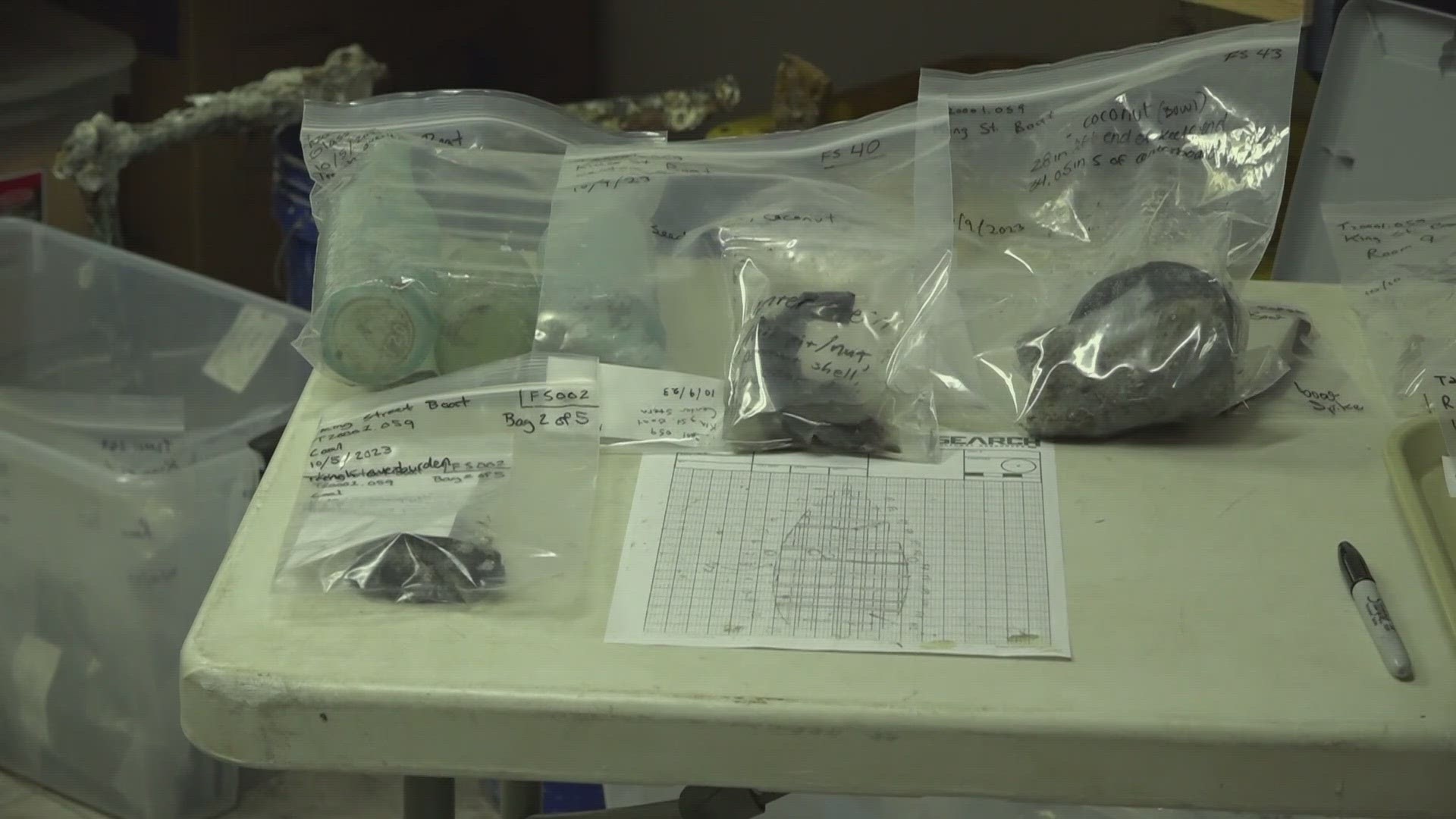ST. AUGUSTINE, Fla. — The intrigue continues surrounding the wooden boat from the 1800s that was found under a road in downtown St. Augustine earlier this month during a construction project.
Archaeologists found dozens of artifacts in and around the boat. Now, those items are at the SEARCH, Inc. lab in Jacksonville. SEARCH is the archaeological firm hired by the Florida Department of Transportation to monitor the road construction site near the Bridge of Lions.
"One thing archaeologists like are personal effects," Geoff DuChemin with SEARCH said as he sorted through trays of artifacts. He and his colleagues are carefully storing and studying the wide-ranging collection of found items.
DuChemin showed off a button made of a shell, a metal cufflink, and a pipe bowl.
These everyday items help paint the picture of the people who used the boat. They're well preserved because the boat was in water and silt for decades.
Some of the items were found actually inside the boat’s bilge which means "these were on board the vessel," Archeologist Sam Turner with SEARCH noted.
Those items found in the bilge help date the boat to the latter half of the 1800s.
"This is a whetstone, most likely for sharpening blades," Turner said, as he held a piece of stone with a flat edge.
He then picked up a shiny brown piece of ceramic, "This is probably part of a pitcher handle."
Items found inside the boat also indicate what the boater could have been eating. There was a plum pit, peanut shells, and squash or pumpkin seeds.
It’s rare for these things to survive for more than a hundred years but, "they fell into a nice anaerobic environment, and that’s why they survived," Turner explained.
Artifacts also indicated the boater was smoking. Archaeologists found what they suspect is a slice of a cigar… amazingly preserved.
The boat may have been also transporting firewood, Turner said, because pine chips were found onboard.
Also, at least two shoes were located
DuChemin pointed to a piece of leather, several inches long. "We found the side piece of the shoes," he said. "You can see the fine stitching here, and we then found a bit of the sole."
A portion of an oil lantern was also found in the boat, which Turner says suggests the boater could have been working when it was dark at some point.
Other items were found around the boat, not necessary in it. They date later or earlier than the 19th century, so they could’ve been dropped at a different time in the area.
DuChemin held a Coca-Cola bottle that was from a Jacksonville factory. He suspects it dates to 1910. Other bottles were found as well.
And then small little bits of cloth blew the scientists' minds. DuChemin recalls thinking, "Holy cow!"
The archeologists showed First Coast News three small pieces of cloth, dark and light in color. They were no bigger than a square inch each. The dark piece had visible tiny holes from previous stitches. Cloth is rare to see buried after all these decades, but again they were well preserved in water and silt.
So how come this boat was found on land?
SEARCH Archaeologist Greg Hendryx said, "The shoreline of St. Augustine has changed over time. We don't know exactly where the shore was when this boat was put down. "
Looking at old maps and sketches of the St. Augustine bayfront, it appears the Matanzas riverbank was not as far out as it is now.
"In the 1830's, there was a wooden bulkhead much further inland than the current seawall," Hendryx said.
Archaeologists believe where the boat was discovered was actually part of the bay then, and that water and silt helped preserve it and all the artifacts.
It's believed the boat came to rest on the water. Hendryx and his team said, "Based on where it (was) we think it was underwater."
And the conditions of that watery home seems to have helped scientists... and those with an active imagination... create an image of a person living a day-to-day life, along the river in St. Augustine.

